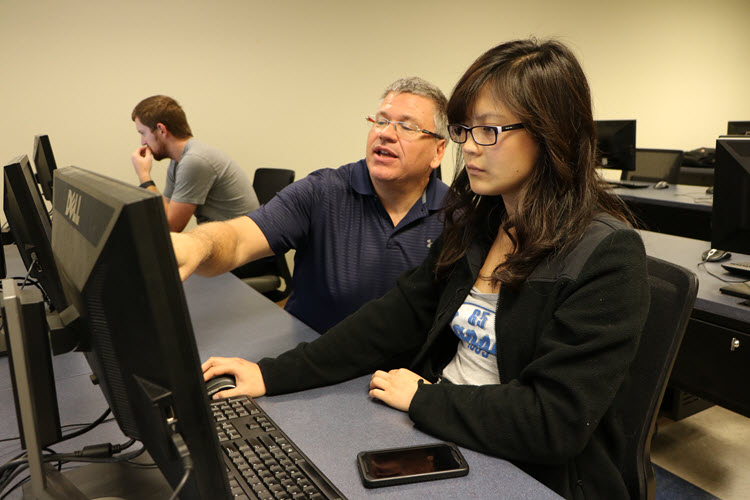By Doug Ward
“What just happened?” Carl Luchies asked his graduate teaching assistant.
They stood at the front of a lecture hall in early 2013, watching as 120 normally subdued engineering undergraduates burst into spontaneous conversation.
Luchies, an associate professor of mechanical engineering, had just given the students a problem to work on and told them it was a collaborative quiz due at the end of class. Students could work with anyone in the room, he said.
“Anyone?” they asked.

Anyone, he said. They could move wherever they wanted to move. Use Google if Google would help. Ask questions of him or the GTA. Do whatever they needed to do to find the answer.
After a few moments of uncertainty, “the class just came alive,” Luchies said.
Luchies was surprised at how successful his experiment was that day, especially because it was a spur-of-the-moment experiment to try to revive a mostly listless class. His willingness to experiment and to focus on the best approaches for students was nothing new, though. He received the school’s Louise Byrd Graduate Educator Award in 2010. And this fall, he received the Outstanding Teaching Award from the Midwest Section of the American Society of Engineering Education. He will now be considered for a similar national award.
Luchies looks at that day in 2013 when the class came alive as a turning point in the way he teaches. Robert Beichner, a professor at North Carolina State and an advocate for active learning in STEM fields, spoke to School of Engineering faculty members the week before classes started that year, urging them to try flipped and hybrid learning in large classes. Luchies was intrigued, but he didn’t think he had time to make changes.
In January and February, though, he realized that few students were listening as he lectured. After 15 to 20 minutes, students began checking their phones or staring blankly. He asked for questions at the beginning and end of each class. Students rarely responded.
“I tried to entertain them,” he said. “I tried to get excited about it. I was using an active display or I was writing out solutions and then automatically putting that on Blackboard so that they could see my solution. I was trying a lot of different things.”
It didn’t matter, though. Students had simply checked out. So he cut back on lectures, gave students in-class problems and told them to work collaboratively.
“All of a sudden, all the students were talking and asking questions, because now they needed to know – they wanted to know – because there was pressure to figure this out before they left the classroom,” he said. “That’s all I had to see. That was like a night-and-day difference between what I had been doing and what I was going to be doing in the future.”

Luchies describes his approach to teaching as one of engagement. He often demonstrates new material to students and then turns them loose to work in groups. He and a teaching assistant move about the room and offer assistance. Each student turns in an assignment, but he encourages the class to work collaboratively to find answers and learn from each other.
“If I explain how to do something, and then I say, OK, now let’s do it, then they have to now think about exactly what I said, what did I mean by what I said, and how do they actually use what I said to solve the problem, do the analysis, whatever it might be,” Luchies said. “That’s when the actual learning goes on. They are actually doing what I just taught them.”
Luchies has gradually expanded and adapted the in-class and out-of-class material for his class over the past few years. He recorded lectures and put them online, created online quizzes, and insisted that students come to class prepared to work collaboratively. He experimented with different types of peer-to-peer learning – pairs of students, groups of three, groups that change during the semester, groups that stay together – before settling on teams of five that work together the entire semester. Eventually, he was able to move out of the lecture hall and into the new active learning rooms at the School of Engineering, add an additional GTA and two undergraduate teaching fellows.
“Each semester, I just went further and further,” Luchies said.
That doesn’t mean that switching to an active learning approach was easy or universally accepted.
“When I first started off there was a lot of pushback,” Luchies said. “There were students who basically told me that for the last 13 years I have learned like a sponge and I don’t see why I have to do any work when I come to class.”
The numbers on Luchies’ student teaching evaluations dropped, and “I had some pretty negative comments.”
As students grew more accustomed to active learning in his class and in other classes, though, the pushback diminished. Most now like the approach Luchies uses, praising the variety of class activities and the ability to develop as teams. Luchies, too, has grown more comfortable with his changing role as a teacher, moving away from lecture and becoming what he described as a mentor or a coach.
“At the beginning I had no idea what I was doing,” he said. “I was just trying things. Now I’m much more intentional about it.”
He describes active learning as a continual learning process for students and instructors.
“Experiential learning goes both directions,” Luchies said. “I have learned a tremendous amount by trying new things and experiencing it and finding out for myself what works and what doesn’t work. Not everything I’ve tried works, but that’s OK. I don’t mind failing.”
Sometimes, though, those experiments pay off, leaving an instructor to ponder a delightful question:
“What just happened?”
Tagged active learning, collaborative learning, flipped courses, learner-centered teaching, qualities of good teaching, STEM